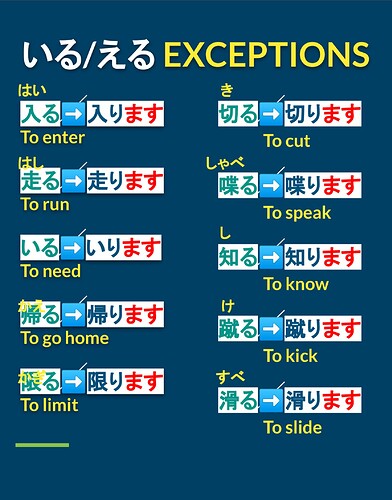Hi everyone!
This is something I wrote in another thread but, given my recent search for more いる/える exception verbs, I decided that it was probably best to place this information in its own dedicated thread.
Unfortunately, a lot of people learn Japanese verb conjugations based on the Genki I (Chapter 3) method, with う- verbs and る- verbs categories. However, I find this unnecessarily confusing and nonsensical, which is why I will share with you what I consider the easiest way to learn Japanese verb conjugations. BTW, this is not something I came up with, but mostly learned in my first couple of months of my journey. Here are the 3 main categories:
1 - Irregular verbs: Mainly 来る and する. The other exceptions are 行く in its past tense form, which becomes 行った (NOT 行いた). The other one is 有る which, in its negative form, becomes ない (NOT ならない).
2- Godan verbs: These are the vast majority of verbs in Japanese (unless you include verbs in the potential form, which would then make Ichidan verbs the most common by a land slide, but that’s another story). Any verb that doesn’t end in an いる/える sound is a Godan verb. There are exceptions though (see the chart below).
3- Ichidan verbs: Are verbs ending in an いる and える sound. But, as mentioned before, there are Godan verbs that do end in an いる/える sound. These are the exceptions verbs:
**
**This chart was taken from the Genki I (Chapter 3) YouTube video by Tokini Andy, which I’ve linked in the 2nd post of this thread.
If you just want to memorize the most basic いる/える exception verbs, then the above chart is probably enough. However, if you want to do a deep dive into memorize most, if not all of them, then here’s a list, sorted by frequency, I found on Reddit:
Exceptions in top 200 (extremely popular words):
知る(shiru) - to know
入る(iru) - to get in
入る(hairu) - to enter
Exceptions in top 1000-2000:
走る(hashiru) - to run
切る(kiru) - to cut
参る(mairu) - to go (humble).
要る(iru) - to need
限る(kagiru) - to limit
Exceptions in top 2000-4000:
焦る(aseru) - to be impatient
帰る(kaeru) - to return home
握る(nigiru) - to grasp, to mold/press into shape.
減る(heru) - to diminish
Exceptions in top 4000-8000:
蹴る(keru) - to kick
散る(chiru) - to fall/scatter (not vertically, as leafs), it’s different from 落ちる to fall straight.
練る(neru) - to knead
Exceptions in top 8000-10000:
喋る(shyaberu) - to chatter
滑る(suberu) - to glide/slide
混じる(majiru) - to be mixed
照る(teru) - to shine
罵る(nonoshiru) - to curse/abuse(verbally)
耽る(fukeru) - to indulge in
Exceptions in top 10000-20000 (relatively rare):
茂る(shigeru) - to grow thickly
湿る(shimeru) - to become moist/wet
弄る(ijiru) - to fiddle
捻る(hineru) - to twist
寝そべる(nesoberu) - to sprawl
嘲る(azakeru) - to scoff/ridicule
齧る(kajiru) - to gnaw
毟る(mushiru) - to pluck
詰る(najiru) - to rebuke
Very rare:
軋る(kishiru) - to creak/squeak
誹る(soshiru) - to slander
せびる(sebiru) - to pester/demand money.
**Link to the above list: https://www.reddit.com/r/LearnJapanese/comments/nj28jv/える_いる_verbs_exception/






